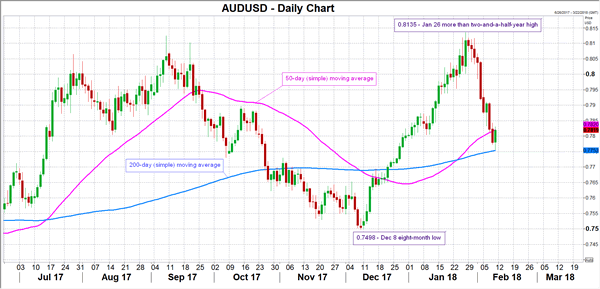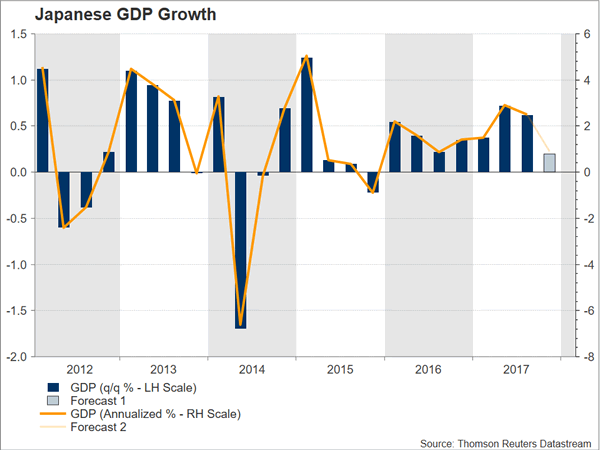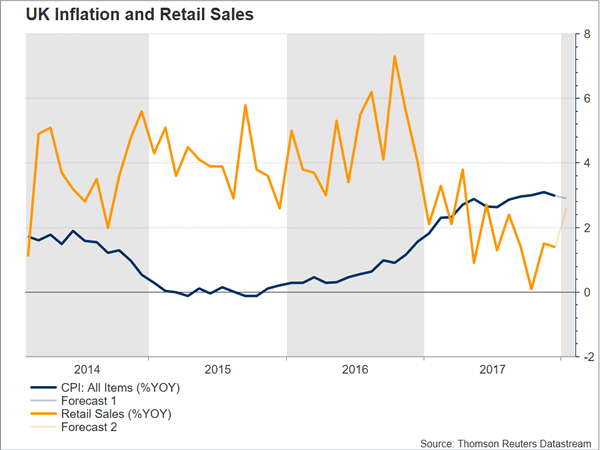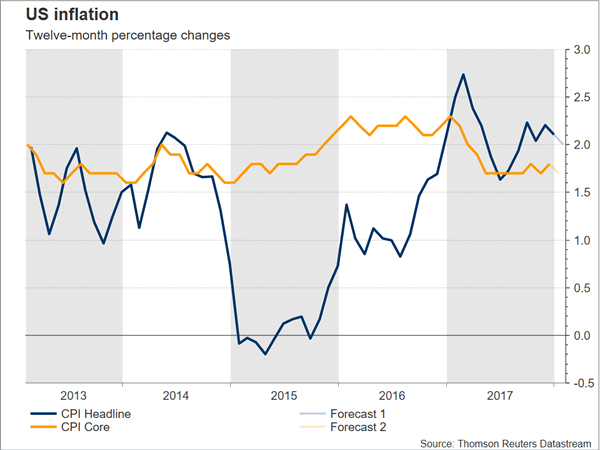On the face of it, it looks that the upcoming week will lack events of similar magnitude to the one we just experienced – for example, the Bank of England meeting and subsequent press conference by Governor Carney. Still, there are releases that have the capacity to keep investors on edge and lead to notable movements in forex markets: US and UK CPI and retail sales, Australian jobs data, and Japanese GDP figures are among the readings that will be closely watched as the week unfolds.
Australian employment report in focus
Australian data on employment (and unemployment) for the month of January will be made public on Thursday at 0030 GMT. December’s net new positions added to the economy stormed past expectations, posting a record-equaling 15th consecutive month of rises along the way; the unemployment rate did rise, though that was attributed to more individuals entering the labor force. It would be interesting to see if next week’s release maintains positive momentum and whether it will lend some support to the local dollar which has experienced notable losses versus the US currency after hitting a more than 2½-year high of 0.8135 in late January.
It should be mentioned however, that an upbeat report would not necessarily translate into a rising currency. In December, labor supply grew by more than labor demand, easing wage growth and consequently inflationary pressures, pushing back in time market participants’ expectations for a rate hike by the Reserve Bank of Australia and leading to aussie weakness.

New Zealand will see the release of electronic card retail sales for the month of January on Sunday (Monday morning for Asian traders).
GDP estimates for Q4 2017 and machinery orders among Japanese releases
January’s corporate goods prices (these being wholesale prices, i.e. what companies charge each other for their goods and services) out of Japan will be released on Monday at 2350 GMT. More importantly, the world’s third largest economy will see the release of preliminary Q4 GDP growth on Tuesday at 2350 GMT. On an annualized and quarterly basis, growth is expected to stand at 0.9% and 0.2% respectively. These compare to Q3’s respective figures of 2.5% and 0.6%, though most analysts anticipate the expected deceleration to be temporary. A reading showing positive growth – as projected by analysts – would translate into eight straight quarters of expansion, Japan’s longest such streak since the period between 1986 and 1989 when the economy grew for 12 straight quarters; though that period was associated with the formation of a bubble. Next in line out of the nation will be December’s machinery orders scheduled for release on Wednesday at 2350 GMT.

Remaining in Asia and turning to China, the world’s second largest economy, data on bank lending are forecast to show that new yuan loans rose to their highest in a year in January following a big decline in December. In general, Chinese banks front-load loans every year to win market share, so one might not read much into the data than otherwise would. Attention, however, remains on government efforts to mitigate risks from rising debt levels. Beyond the yuan, it is invariably the case that markets also pay attention to the Australian dollar ahead of and in the aftermath of Chinese releases; the aussie is viewed as a liquid proxy for China’s economy due to the two nations’ strong economic ties. Lending data out of China are tentative however, lacking a specific date and time of release (they have a release window that spans between February 12 and 19).
Second release of Q4 2017 eurozone GDP, UK inflation & retail sales make list of European releases
Of most interest out of the eurozone will be the second release of Q4 2017 GDP growth out on Wednesday at 1000 GMT. Quarter-on-quarter, the pace of expansion is anticipated at 0.6%, the same as in the first release and below Q3’s respective figure of 0.7%, while annualized growth is projected to come in at 2.7%, in line with the first release and again below Q3’s respective figure of 2.8%, a rate of growth last achieved in Q1 2011. Data on eurozone industrial production for the month of December will be released at the same time. A few hours earlier (at 0700 GMT), Germany, the eurozone’s and Europe’s largest economy, will see the release of flash Q4 2017 GDP growth estimates and final inflation figures for the month of January.
Out of the UK, January’s inflation figures and data on retail sales for the same month scheduled for release on Tuesday and Friday (both at 0930 GMT) will be drawing most attention, having the potential to lead to positioning on sterling. On a monthly basis, headline CPI is projected to contract by 0.6% and on a yearly basis to expand by 2.9%, continuing to ease after hitting a near six-year high of 3.1% in November and lending support to those saying that it will start to gradually slow, moving towards the Bank of England’s target for annual inflation of 2%; though it might be early to conclusively state that a gradual slowdown is taking place. January’s producer prices are also due on Tuesday at the same time as CPI numbers, while core inflation will also be attracting interest.
On the UK retail sales front, those are expected to rebound after December’s contraction on a monthly basis. Last year, retailers experienced their worst year since 2013 as inflation outstripping wage growth – translating into weaker purchasing power for households – weighed on consumer spending and consequently retail sales. It will be interesting to see to what extent this would continue moving forward.

Lastly out of Europe, the Riksbank, Sweden’s central bank, will be deciding on rates on Wednesday.
CPI, retail sales, industrial & manufacturing output on US agenda
In terms of US releases, Wednesday’s inflation and retail sales figures (both due at 1330 GMT), Thursday’s industrial production (due at 1415 GMT), and Friday’s data on housing starts (due at 1330 GMT) as well as the University of Michigan’s preliminary survey on consumer sentiment for the month of February (due at 1500 GMT) are expected to generate most investor interest. Barring the University of Michigan’s survey, all other releases will pertain to the month of January.
There are rising inflation expectations as of late in the US, and Wednesday’s CPI figures could show – a least to an extent – whether those are justified. Headline CPI is projected to grow at a stronger pace on a monthly basis, while on an annual basis it is expected at 2.0%, slightly below December’s 2.1%. Annually, core inflation is also anticipated to tick slightly lower, with analysts projecting it at 1.7% versus December’s 1.8%. The Federal Reserve’s preferred inflation measure is the core personal consumption expenditure (PCE) index, but still forex market participants will be paying attention to the data as they can give insights on the speed with which the US central bank will continue to tighten its policy.

In terms of other data out of the US, retail sales in previous months showed positive momentum and it would be interesting to see whether that is carried through into 2018. Industrial production is expected to ease to a growth rate of 0.2% on a monthly basis, after beating expectations in December to expand by 0.9% m/m; manufacturing output, a subset of industrial output, will also be watched. Housing starts were affected by cold weather conditions in December, recording their sharpest monthly fall in around one year. As the extreme weather effects are dropping out of the data, a rebound is to be anticipated. Finally, the University of Michigan’s survey is projected to show that consumer sentiment remained around the same levels as in January.
Out of Canada, manufacturing sales for the month of December due on Friday will be gathering some interest.














